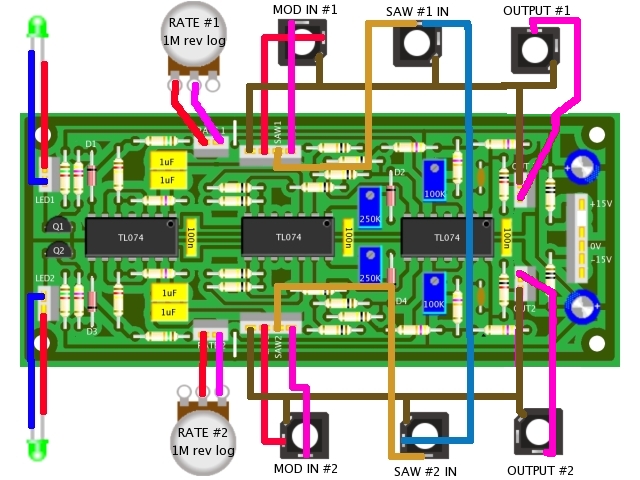| Modified : april 16th. 2017 |
Saw Animator
|
 |
back to summary |
 |
 |
| Description |
| Modified : april 16th. 2017 |
Saw Animator
|
 |
back to summary |
 |
 |
| Description |
|
 |
 |
Schematic |
 |
 |
 |
 |
List of parts and building instructions
|
|||||||||||||||||||||||||||||||||||||||||||||||||||||||||||||||||||||
|
|||||||||||||||||||||||||||||||||||||||||||||||||||||||||||||||||||||
| Wiring |
|||||||||||||||||||||||||||||||||||||||||||||||||||||||||||||||||||||
 |
 |
 |
 |
 |
Trimming
|
| There are four trimmers
to be adjusted. Note that the adjustment procedure is
the same for T1 and T3 and for T2 and T4. Setting of T1 (SHAPE trimmer).
Setting of T2 (BALANCE trimmer)
Unground the MOD IN #1, you must see the sawtooth swaying at the rhythm of the internal LFO Repeat the same settings to adjust T3 and T4. |
 |
 |
References |
Bernie Hutchins ,
JAES 1981 "Analog circuit for Sound Animation", and
Electronotes #87  Digisound 80 Modular, Waveform multiplier  Scott Bernadi's, Obesifier Waveform Animator, OG3 synth  Elektor november 1982, (french version only !)  |
 |

|
|
| Name : Louis
van Dompselar Pseudo : Etaoin Modular project : Casia MS01 Location : Utrecht, Netherlands Website : www.casia.org/modular |
Name :
Patrick Pseudo : Baronrouge Modular project: JHC live lab Location: Toulon, France Web site : http://myspace.com/patjhc |
Name :
Paul Darlow Pseudo : Krisp1 Modular project: Krisp1 Location: Web site :http://www.krisp1.com |
 |
  |
  |
| Name: Bill and Will Pseudo: 'ills Modular Project: Dragonfly Alley Location: New Jersey, USA Website: dragonflyalley.com |
Name: David M. Ingebretsen Pseudo: digembre Modular Project: Location: Salt Lake city, USA Website: www.xmission.com/~dingebre |
Name : Frédéric Monti Pseudo : zarko Modular project : Location : Gardanne, France Website : |
  |
||
| Name : Steven Brenner Pseudo : Modular project : Location : Waterloo, Ontario, Canada Website : |
|
|||
 |
 |